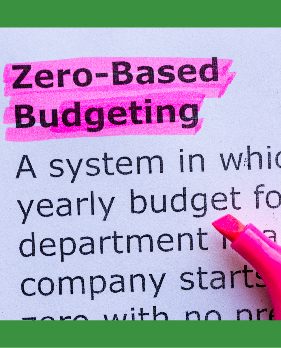Zero-Based Budgeting and the 50-30-20 Rule
Creating and following a spending plan (or a budget) is essential to manage your finances effectively, ensure that you live within your means, save for future goals, and avoid unnecessary debt.
Two popular budgeting methods are Zero-Based Budgeting and the 50-30-20 Rule. Each has its unique advantages and disadvantages. Which one might be the best fit for your financial situation? Let’s take a closer look at these two budgeting approaches.
Zero-Based Budgeting (ZBB) Gives Every Dollar a Purpose
It is a budgeting method formed with the goal that your income minus expenditures should equal zero by the end of the month. All your needs and wants, as well as short- and long-term savings and debt payments should be fully allocated.
Pros:
- Detailed Tracking: Every dollar is assigned a specific purpose, which provides a clear and detailed view of your spending. This level of detail helps identify and eliminate unnecessary expenses.
- Financial Control: Budgeting every dollar encourages proactive management of your finances and reduces wasteful spending.
- Goal-Oriented: ZBB can be tailored to meet specific financial goals, such as saving for a major purchase, paying off debt, or investing.
- Adaptability: This method can be adjusted monthly based on changing income and expenses, providing flexibility and responsiveness to financial changes.
Cons:
- Time-Consuming: The detailed nature of ZBB requires significant time and effort to maintain, which can be a drawback for those with busy schedules.
- Complexity: For those who are not accustomed to detailed financial planning, ZBB can be overwhelming and difficult to implement.
- Rigid: While ZBB can be adapted monthly, it can feel restrictive, especially if unexpected expenses arise that were not accounted for.
The 50-30-20 Rule Promotes a Balanced Approach
This budgeting method places your after-tax income into three categories: 50% for needs, 30% for wants, and 20% for savings or debt repayment.
Pros:
- Simplicity: The 50-30-20 Rule is easy to understand and implement, making it accessible for beginners. It divides after-tax income into the three broad categories listed above.
- Flexibility: This method allows for flexibility within the broad categories, making it less restrictive and easier to stick to over time.
- Balanced Approach: It promotes a balanced financial life by ensuring that you are not only covering your essentials, but also setting aside money for savings and allowing for discretionary spending.
Cons:
- Lack of Detail: The broad categories may not provide enough detail for those who want to closely track their spending or have specific financial goals.
- Oversimplification: The 50-30-20 Rule might not fit everyone's financial situation, especially if their income or expenses do not align neatly with the percentages.
- Potential for Overspending: The flexibility in the "wants" category might lead to overspending if not monitored carefully.
Which One to Choose?
You may want to consider Zero-Based Budgeting if:
- You prefer a detailed and highly controlled budgeting approach.
- You have specific financial goals or are trying to pay off debt aggressively.
- You are willing to invest the time and effort to maintain this level of detail.
You may want to consider the 50-30-20 Rule if:
- You are new to budgeting and want a simple, straightforward method.
- You prefer a more flexible approach to managing your money.
- Your financial situation aligns well with the 50-30-20 categories.
Some individuals may even find that a combination of both methods works best for them, by using the detailed tracking of ZBB for certain expenses while applying the 50-30-20 rule for overall financial management. You can also use budgeting apps such as You Need a Budget, Monarch, or Tiller; or a spreadsheet; or even pen and paper. Ultimately, the best budgeting method depends on your personal financial goals, lifestyle, and preferences, as well as the budgeting method you’re most likely to maintain.








 Next
Next


